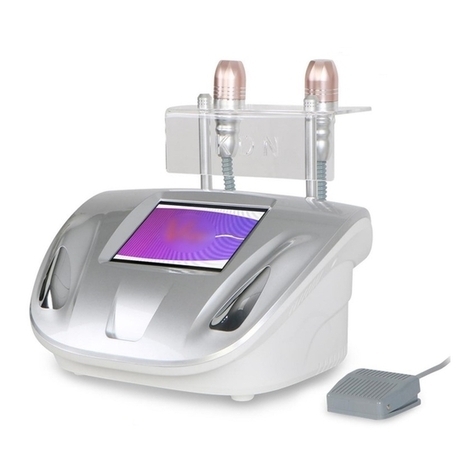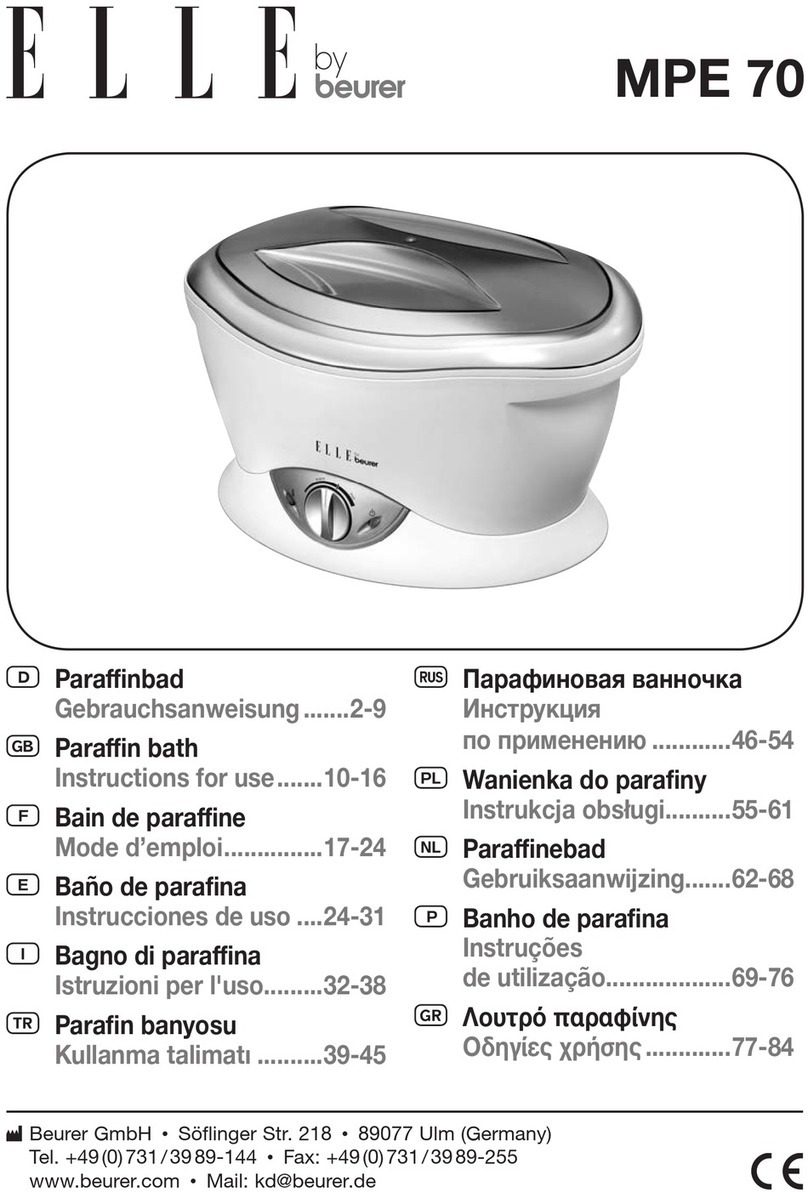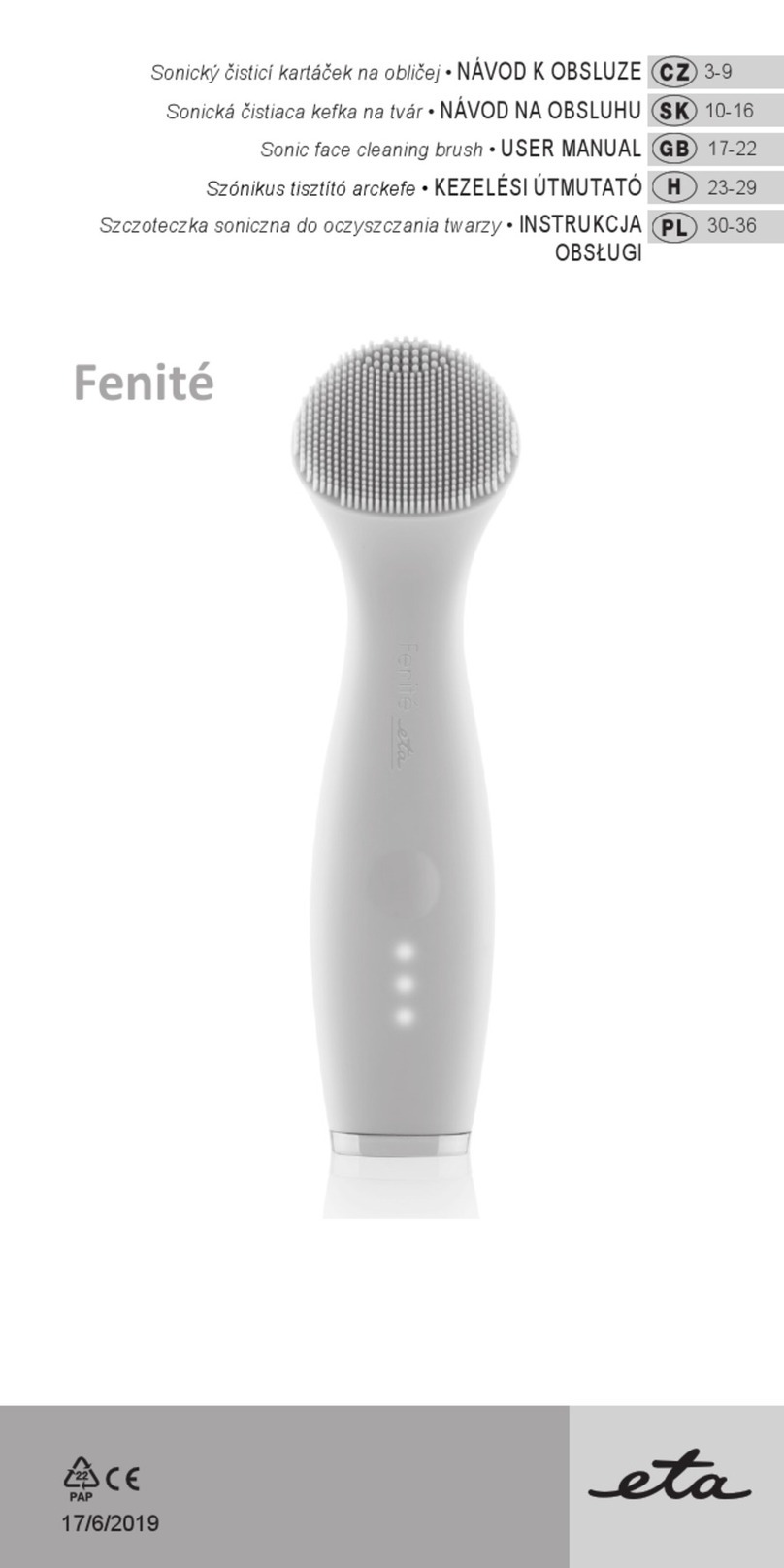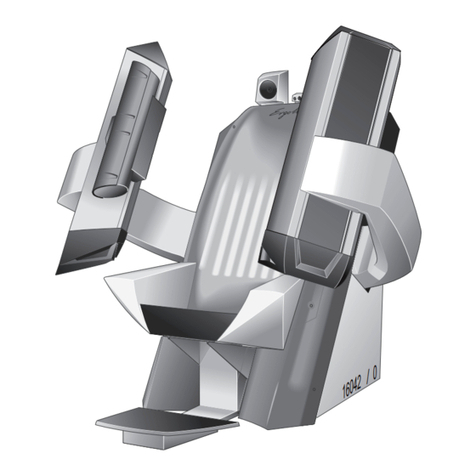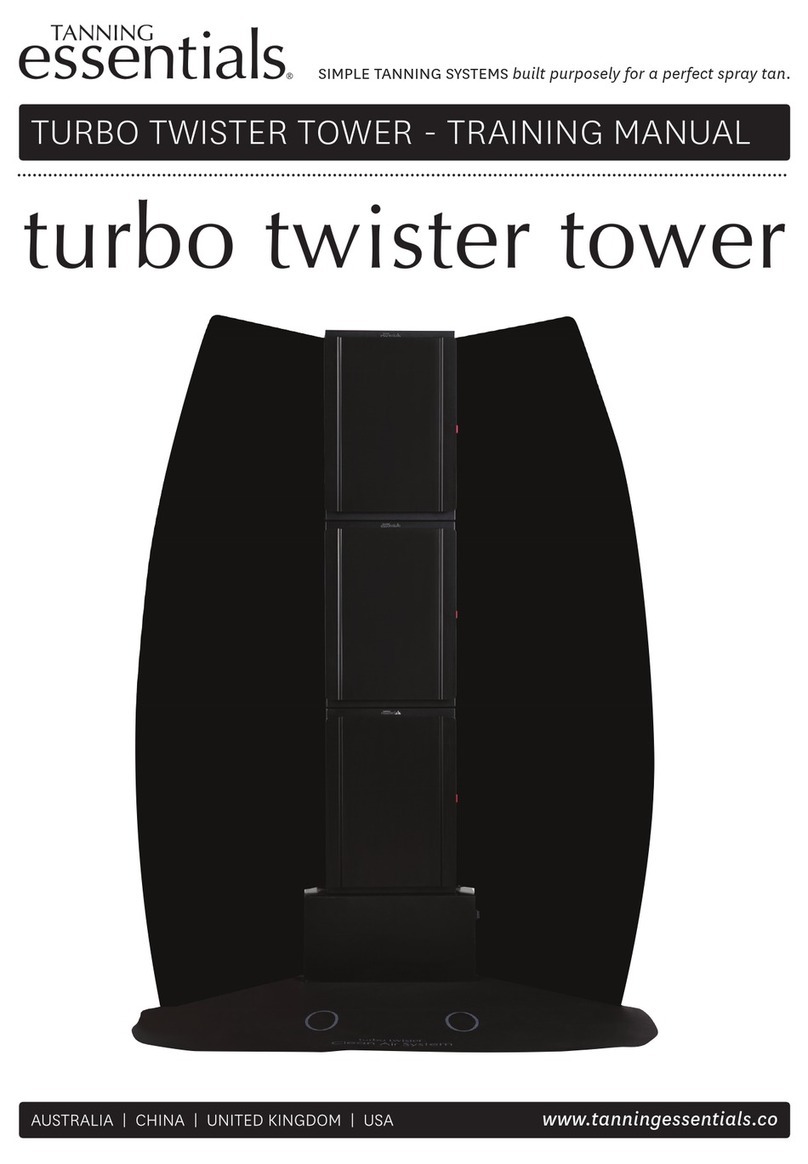Elamed DIAMAG User manual

DIAMAG
Operating Manual Page 1
Dear Customer!
Thank you for purchasing DIAMAG, a device specially designed for
treatment of brain diseases with a low-frequency, low-intensity pulsed
magnetic field at home.
The procedures done by the patient at home do not require special
training or special skills. Please make sure to carefully study the medi-
cal Operating Manual before starting the procedures and correctly fol-
low the treatment methods. This will ensure the most efficient use of
the device.
ATTENTION! The device should be used to treat the diseases
listed in the «Indications»section only after a precise diagnosis
has been established.
ATTENTION! No special training or skills are required to carry
out the procedures by the patient at home. To ensure efficient
use of device, please carefully study this Operating Manual.
This Operating Manual is a document identifying the basic technical
characteristics and parameters of the device, indications for its use and
the treatment procedures certified by the Manufacturer.
Please keep the Operating Manual throughout the whole service life.
When handing DIAMAG over to another user, please make sure to
hand in the Manual as well.
TABLE OF CONTENTS
Safety Instructions
3
Intended Use and Operating Principle
5
Transportation and Storage
7
Delivery Set
7
Indications
7
Contraindications
7
Directions for Use
9
Treatment Procedures
13
Maintenance Support
18
Specifications
18
!
!

DIAMAG
Operating Manual Page 2
+35 ºС
+10 ºС
Guidance and manufacturer’s declaration –electromagnetic
emissions and immunity
21
Acceptance Certificate
25
Manufacturer`s Warranty
26
SYMBOLS ON THE DEVICE
Warnings related to safety and effective operation.
The housing is protected with reinforced insulation.
No safety grounding is required.
Read the Operating Manual carefully.
Applied part type BF. Emitter is protected with reinforced
insulation.
Operating ambient temperature: from +10 ºC to +35 ºС.
THE LIST OF STANDARDS USED
EN ISO 10993-1:2009+Cor.1:2010
EN 60601-1:2006+AC:2010
DIN EN ISO 15223-1:2013
EN 60601-1-8:2007 +AC:2010
!

DIAMAG
Operating Manual Page 3
SAFETY INSTRUCTIONS
Please read this Operating Manual carefully before starting the
treatment and routine procedures.
Carry out the procedures in places suitable for plugging the de-
vice into the power supply socket without straining the mains
cord or the emitters` cables; otherwise use power extenders of
industrial production. The DIAMAG device is to be connected only to a
properly functioning socket with an operating voltage of ~220-
230V/50Hz or ~120V/60Hz (see marking).
No lifting, carrying, or unplugging the device by pulling the mains cord
is allowed.
To avoid possible damage to the device, keep it away from the
reach of children.
Make sure to do visual examination of the device prior to start-
ing the treatment procedure. Using the device if its housing, emitters or
cables are damaged is PROHIBITED!
Please store and use the control unit and emitters only in dry
places.
Avoid penetration of moisture inside the control unit and emit-
ters while treating their surfaces with disinfectant solution. Pro-
tect the device from dampness, shock and impact.
Keep the device away from direct sunlight and high tempera-
tures.
After storage or transportation of the device at low tempera-
tures, keep it at room temperature for at least four hours prior to
usage start.
Do not twist or bend the cables; store the device in the con-
sumer container after its usage.
Do not place an operational device nearby (less than 0.5 m
apart from) magnetic data carriers (floppy disks, credit cards,
video records, mobile memory units).

DIAMAG
Operating Manual Page 4
Instructions on environmental protection: Dispose of the
device upon termination of its service life as electronic waste at
specialized recycling points.
Exclusion of liability: the Manufacturer shall not be held liable
for damages resulting from non-observance of the above in-
structions.

DIAMAG
Operating Manual Page 5
Fig. 2
Fig. 1
INTENDED USE AND OPERATING PRINCIPLE
The device is designed for physiotherapy of brain diseases with a
low-frequency low-intensity magnetic field.
The device can be applied at physiotherapy departments and offices
of healthcare facilities, as well as in home conditions by the patients
themselves upon doctor`s advice. Device operation does not require
any special training. The device consists of a control unit (Fig.1) and
a «headband»-type emitter (Fig.2).
The «headband»emitter
consists of two flexible emit-
ting lines. Each of the lines
contains 6 individual induc-
tors (emitters). The working
surface of the emitters is
designated with an «N» la-
bel (north).
The unit generates two types of pulsed magnetic fields: «travel-
ling»and «static»(Fig. 2).
Power switch
emitters
flexible emitting
line
cable
buckles
Labeling of the
field polarity
(N-north)
Control board

DIAMAG
Operating Manual Page 6
The «travelling»type field is
one which produces sequential
excitation of all the emitters of the
flexible lines, running from the 1st
emitter to the 6th in cycles (Fig.3).
The «travelling»field, depending
on the program selected, is
formed either with single or
‘grouped’ pulses (pulse packets).
The «static»type field presumes
simultaneous excitation of all the
emitters.
FUNCTION OF THE CONTROL AND DISPLAY BOARD
The front panel of the control unit
has the following controls and dis-
displays (Fig. 4):
1 –The LED displaying (depend-
ing on the operating mode) either
the program number, or the mag-
neto-action as a moving luminous
circle segment, or the «E»(error)
symbol;
2 –The «PROGRAM»button is
used to select the exposure pro-
gram number;
3 –The «START/STOP»button
is used to switch on/off the magneto-action.
EXPOSURE INITIATION
Exposure is started by single-shot pressing of the
«START/STOP»button.
EXPOSURE TERMINATION
Exposure is terminated automatically (upon termination of the ex-
posure procedure) or forcedly by repeated pressing of the
«START/STOP»button.
Fig. 3
Fig.4

DIAMAG
Operating Manual Page 7
TRANSPORTATION AND STORAGE
The device endures storage in a non-heated storage room with
air temperature from -50 °С to +40 °С with relative air humidity of up
to 98%.
The device can be transported by all covered vehicles in compli-
ance with the rules of carriage applicable to a specific carrying vehi-
cle with air temperature from -50 °С to +50 °С and relative air hu-
midity of up to 98%. DELIVERY SET
The complete delivery set of DIAMAG is listed in Table 1. Table 1
Item
Quantity
Control unit
Flexible emitting line
Elastic band
Operating Manual
Magnetic field indicator
1
2
2
1
1
INDICATIONS
- After-effects of a cerebrovascular accident;
- Transient ischemic attack,
- Chronic cerebral ischemia;
- Migraine (hemicrania), migraine neuralgia;
- Osteochondrosis of the cervical spine with symptoms of cephalgia,
cranialgia;
- Chronic iridocyclitis.
Further areas of application:
- Parkinson's disease: prevention of disease progression
- Sleep disorders.
CONTRAINDICATIONS
- Malignant neoplasms;
- Severe cardiac arrhythmia (atrial fibrillation, paroxysmal tach-
yarrhythmia);
- Presence of an artificial pacemaker;
- Infectious diseases in the acute stage and fever of anyorigin;
- Respiratory failure;

DIAMAG
Operating Manual Page 8
- Acute purulent processes on the head;
- Active tubercular process;
- Aneurysm of the cardiac vessels, aorta and other large vessels, or a
tendency for bleeding;
- Psychological or alcohol-induced excitability;
- Thrombocytopenia, bleeding and coagulopathy;
- Systemic blood diseases;
- Hyperthyroidism;
- Pregnancy.
ATTENTION! Presence of metal dental prostheses is not
a contraindication against treatment.
THERAPEUTIC EFFECTS OF DIAMAG
FOR DIFFERENT DISEASES
During clinical trials involving treatment of stroke patients and pa-
tients suffering from other cerebrovascular diseases, the following
clinical effects were recorded:
- Reduction of elevated systolic (top) and diastolic (lower) blood
pressure;
- Changes in blood oxygen saturation, indicating activation of
metabolic processes;
- Normalization of blood coagulation;
- Restoration of sensitivity;
- Anesthesia;
- Normalization of muscle tone;
- Reduction of the level of anxiety (fear of death), irritability;
- Restoration of sleep.
The treatment of Parkinson's disease patients demonstrated an
improvement of their general health due to normalization of the car-
diovascular system and reduction of the originally increased muscle
tone, thus facilitating the patients’condition and improving their qual-
ity of life.
Treatment of the eye diseases produced the following confirmed
results: increased vision acuity, improved light sensitivity, increased
limits of the visual field, and improved trophism in the retina and op-
tic nerve.
During treatment of migraine attacks with DIAMAG, the patients
stated either a complete relief of the pain attack without using pain-
!

DIAMAG
Operating Manual Page 9
killers or a decrease in its intensity to a tolerable level that did not
require using painkillers.
DIRECTIONS FOR USE
PREPARATION OF THE DEVICE FOR OPERATION
After storage in cold premises, the device should be warmed up to
room temperature for 4 hours before use.
Disinfection of the device components is required prior to its first us-
age and later on when necessary (for example, when handing the de-
vice over to another person for use in home conditions).
Disinfection of the outer surfaces of the control unit, flexible emit-
ting lines, and elastic bands should be performed by wiping them
twice with a heavy muslin or gauze clothmoistened with a disinfectant
solution. It is recommended to use (0.5-1)% aqueous solution of
chlorhexidine (hibitane) as a disinfectant solution, which can be pur-
chased at a pharmacy. The product is odorless and belongs to a
class of low-hazard substances. The solution can be prepared in any
dish by mixing it with water. The interval between the wipings should
be at least 15 minutes. Make sure to squeeze the cloth out in order to
avoid leakage of the solution inside the unit and emitter lines during
disinfection of the surfaces. Then wipe the surfaces with a napkin
moistened with water and squeezed out, and dry them at an ambient
temperature of up to +50 °C.
ATTENTION! Please wear rubber gloves while preparing the
solution.
OPERATING PROCEDURE
Prior to starting the magnetotherapy procedures, make sure the de-
vice is in operable condition: check the respective indication on the con-
trol unit for availability of program setting and magnetic induction gen-
eration.
Note:
- In case of malfunction during the exposure session, the device
produces a sound indication and an «E» symbol is displayed in the
control board display box.
- Presence of magnetic field on the working surfaces of the emitting
lines can be checked with the help of a magnetic field indicator.
!

DIAMAG
Operating Manual Page 10
Fig. 6
Fig. 5
The LED on the indicator starts flashing when placed against the
working surfaces of the emitting lines, confirming the magnetic field
presence.
In order to fix the emitter lines on the patient's head, use special
elastic bands. To do this, place the flexible emitting lines against one
another as shown in Figure 5. Pull one elastic band through the
«front»line buckles (Fig. 6), and the other elastic band in the same
way through the «rear»buckles. Place the emitter on the patient’s
head as described below (see Fig. 7 for an example). For a tighter fit of
the emitters around the patient’s head, pull the loose ends of the elas-
tic bands.
Rear buckles
Front buckles
Elastic bands

DIAMAG
Operating Manual Page 11
Use of the DIAMAG Device
Using the «POWER»switch, turn the device
power on. With that, the number of the last program
used shall be displayed in the control board display
box (Fig. 8).
With the help of the «PROGRAM» button,
set the number of the required program (to be
selected as per the «Treatment Procedures»
section of the Operating Manual).
Note: In case of a course treatment, when one
and the same exposure program is used, there is no
need for a repeated setting of the program number.
Place the emitters as described in the Operating
Manual, with the working surface marked with
«N» (north pole) turned towards the affected ar-
ea.
For example, Fig. 7 shows placement of the
emitters for treatment of brain diseases.
Note: In order to enhance bio-safety while per-
forming the procedures and to prevent emit-
ters’ contact with the patient’s skin and hair, it
is recommended to use disposable materials (such as a non-woven
cloth or a medical cap).
Press the «START/STOP»button to
initiate generation of a preset magneto-
action, while the LED display will be
showing the time remaining until the end
of the procedure, with the dot in the lower
right corner blinking (Fig. 9).
After the countdown of the pre-
programmed exposure time is over, a
sound indication of the procedure end will
be generated, and the LED display will
return to the last used program number.
After termination of the exposure procedure, take the emitter off.
If a next magnetotherapy session is not planned, switch the device
off and unplug it from the mains.
Fig. 7
Fig.8
Fig. 9
Blinking dot

DIAMAG
Operating Manual Page 12
Parameters of the Exposure Programs
Program 1
Type of pulsed magnetic field
travelling
Exposure mode
continuous
Action mode
by pulse packets
Repetition frequency of pulse packets / sec
1-5
Pulse frequency within the packet / sec
7
Field density, mT
10
Exposure time, min.
20
Program 2
Type of pulsed magnetic field
travelling
Exposure mode
continuous
Action mode
by single pulses
Pulse frequency / sec
7
Field density, mT
10
Exposure time, min.
20
Program 3
Type of pulsed magnetic field
travelling
Exposure mode
continuous
Action mode
by pulse packets
Repetition frequency of pulse packets / sec
5-15
Pulse frequency within the packet / sec
30
Field density, mT
10
Exposure time, min.
20

DIAMAG
Operating Manual Page 13
Program 4
Type of pulsed magnetic field
static
Exposure mode
continuous
Action mode
by pulse packets
Repetition frequency of pulse packets / sec
1-5
Pulse frequency within the packet / sec
7
Field density, mT
8
Exposure time, min.
20
TREATMENT PROCEDURES
THE RULES OF PROCEDURES IN MEDICAL FACILITIES
Treatment of cerebrovascular accident (stroke) after-effects,
transient ischemic attacks, chronic ischemia of the brain (cerebral
arteriosclerosis) at all stages.
DIAMAG is used for treatment of the after-effects of a cerebrovascu-
lar accident in the acute and sub-acute periods, and the period of re-
sidual effects. In the acute period, treatment by DIAMAG is provided
in regional or primary vascular care facilities, while in the sub-acute
and residual effects periods it is done in rehabilitation departments
or at home.
Transcranial magnetic treatment is applied as part of the rehabilita-
tion complex for cerebral stroke, after patient’s transfer from the in-
tensive care unit to the unit for patients with acute stroke, starting on
the 5th-7th day from the time of disease progression. The procedures
are performed by medical personnel directly in the ward.
The emitters are placed on the patient's head with the «N» (north)
side towards the head in such a way that the No. 1 emitters of each line
(refer to Fig. 2) are over the occipital region, while the No. 6 ones are
over the extreme frontal part. Treatment in the first 7-10 days is carried
out according to the Program 1 procedure. The subsequent 7-10 treat-
ment days follow the Program 2 procedure. The procedures are given

DIAMAG
Operating Manual Page 14
once or twice a day. The treatment duration is up to 20 minutes and is
determined by the attending physician depending on the patient’s con-
dition.
The course length is up to 20 days. Repeated courses are to be car-
ried out in 1.5-2 months.
Home treatment of cerebrovascular accident (stroke) after-
effects, transient ischemic attacks, chronic ischemia of the brain
(cerebral arteriosclerosis) in the sub-acute period and the period
of residual effects.
If a patient has previously been under DIAMAG treatment in a
specialized care unit, then (s)he or their relatives need to confirm the
treatment methods with the doctor who had previously appointed the
treatment with DIAMAG to ensure the most effective use. Repeated
treatment with DIAMAG of stroke after-effects, transient ischemic attack
and chronic brain ischemia is to be performed 1.5 months after the pre-
vious course of magnetic therapy.
If the device has not been applied in a healthcare facility in the
acute phase of stroke, it is necessary to consult a physiotherapist or
a local physician.
After the consultation, the patient can conduct the procedure ei-
ther by him(her)self, or with the relatives’ assistance, making sure to
check the blood pressure before the procedure and 20-30 minutes
after it. This is done to evaluate the patient’s level of magneto-
sensitivity and the overall treatment effect.
Note: In rare cases (0.5%), increase or decrease of blood pressure
has been observed after treatment with DIAMAG. If after the proce-
dure the blood pressure has changed for 10-25 mmHg or less, then
during the following procedure the exposure time is to be shortened
by 1/3. If the blood pressure after the procedure has dropped or in-
creased by over 25 mmHg, then, before performing the following
procedure, make sure to consult a physiotherapist or attending phy-
sician to adjust the treatment method.
If for any reason receiving medical advice is impossible, please
follow the treatment method described below (provided there are no
contraindications as set out above in this Manual).

DIAMAG
Operating Manual Page 15
TREATMENT METHOD
The emitters are placed on the patient's
head with the «N» (north) side towards the head
in such a way that the No. 1 emitters of each
line are over the occipital region, while the No. 6
ones are over the frontal part (Fig. 10). Treat-
ment in the first 7-10 days is carried out accord-
ing to the procedure of Program 1 (figure «1» is
entered in the display box).
The first 2 days of treatment are to be per-
formed for 5 minutes once a day, with blood
pressure control before and after the procedure.
In case of good treatment tolerability (without
blood pressure changes and without excessive sleepiness), the proce-
dures are carried out twice a day. The first procedure is carried out in
the morning, the second procedure is to be carried out no later than 2
hours before sleep. The minimum interval between the treatments is 6
hours. Within the following 3 days, exposure duration is 7 minutes,
once or twice a day. In the remaining days of treatment under Program
1, the duration should be 20 minutes.
During the subsequent 7-10 days, the treatment procedures are
conducted by the method of Program 2. The procedures are to be per-
formed the same way: once or twice a day.
Migraine, migraine neuralgia.
ATTENTION! With migraine patients, you must always
have DIAMAG at hand to be able to carry out the procedure
at the first sign of an incipient migraine attack. Timely procedures
help to prevent the attack.
Treatment method
The emitters are placed on the patient's head with the «N» (north)
side towards the head in such a way that the No. 1 emitters of each line
are over the occipital region, while the No. 6 ones are over the frontal
part. Treatment of an acute migraine attack is carried out by the proce-
dure of Program 1 (figure «1» is entered in the display box).
Since all patients are different, the procedure duration may vary
greatly. The main criterion of the procedure length is the presence of
the pain syndrome.
!
Fig. 10

DIAMAG
Operating Manual Page 16
Fig. 11
The best procedure duration is until the pain ceases + 2 minutes af-
ter that. For instance, when a patient is suffering from a migraine attack
and starts the treatment procedure with DIAMAG, the pain stops after
12 minutes. The exposure should then continue for another 2 minutes
before the procedure is ended. The total time is thus 14 minutes, after
which the «headband»is removed, and the device is switched off. The
maximum procedure time should not exceed 20 minutes. After the pro-
cedure, the patient must lie down for 1-2 hours, which usually helps to
prevent resuming of the attack.
After termination of the migraine attack, it is necessary to perform a
7-day course treatment as provided in Program 1, followed by another
7-day treatment under Program 2. Procedure length –20 minutes.
In case of further recurrence of the migraine attacks, their intensity
will be much lower, so the treatment course length can be reduced. A
repeated treatment course is carried out as follows: Program 1 proce-
dure for the first three days, followed by 5-7 days of Program 2 proce-
dure. Procedure length –20 minutes.
Chronic iridocyclitis.
Treatment method
The emitters are placed on the patient's head
with the «N» (north) side towards the head so
that the No. 1 emitters of each line are over the
occipital region, then the emitting lines pass over
the auricles, while the No. 6 emitters of both lines
cover the patient’s eyes (Fig. 11). Treatment is
carried out as set out in Program 3. The course
length is 10-20 days. The procedures within the
first 3 days should be 7 minutes long and be ac-
companied by arterial blood pressure control.
The procedures are done once or twice a day.
The duration of the subsequent procedures is 20 minutes. The course
length may be extended if found necessary by the physiotherapist or
attending physician.
Parkinson's disease.
Parkinson's disease is a chronic, constantly progressing disease of
specific brain structures which causes cell degeneration and manifests
itself in the form of a «shaking palsy»that greatly impairs the quality of

DIAMAG
Operating Manual Page 17
life. Treatment with the DIAMAG device is needed to prevent further
degeneration of the cells and to stimulate their further functioning.
Treatment method
The emitters are placed on the patient's head with the «N» (north)
side towards the head so that the No. 1 emitters of each line are over
the occipital region, the middle emitters pass over the auricles, and the
No. 6 emitters of both lines are over the frontal part. Treatment is car-
ried out by the method of Program 4. For the first 3 treatments, the ex-
posure time should be 7 minutes. Before and after the procedure, blood
pressure is to be monitored. The duration of the following procedures is
20 minutes once a day.
The course length is up to 20 days. The course length may be ex-
tended if found necessary by the physiotherapist or attending physi-
cian. Repeated treatment courses, if necessary, are carried out in 1.5 -
2 months.
Sleep disorders.
Treatment method
The emitters are placed on the patient's head with the «N» (north)
side towards the head in such a way that the No. 1 emitters of each line
are over the occipital region, while the No. 6 ones are over the frontal
part. Treatment is performed just before bedtime as set out in Program
1. The duration of the first 3 treatments is 12 minutes, of the subse-
quent ones –20 minutes. The course length is 10-20 days. Procedures
are conducted once a day.
Osteochondrosis of the cervical spine with symptoms of
cephalgia, cranialgia.
Treatment method
The emitting lines are separated
and placed along both sides of the
cervical spine, the «N» (north) side
turned towards the body. The No. 1
emitters are placed over the occipital
region so that the exposure is di-
rected to the first and second cervi-
cal vertebrae. Follow the method of
Program 2. After that, the emitting
lines are fastened together into a ring
and placed onto the head in such a
Fig. 12

DIAMAG
Operating Manual Page 18
way that the No. 1 emitters are located over the occipital region, with
the «N» (north) side facing the head. The methodology is the same.
The duration of exposure of the spine and head during the first 3 treat-
ments is 10 minutes; the subsequent procedures are to last 15 minutes
for each region.
The procedures are carried out once a day. The course length is 10-
20 days.
MAINTENANCE SUPPORT
Maintenance of the DIAMAG device includes preventive inspection,
cleaning from dust and dirt, disinfection, and periodic control of its op-
erability.
The periodic control of the device operability is to be carried out at
least once a year. For this purpose, do the following:
- arrange the flexible emitting lines in a way to provide access to all
the emitters;
- plug the device into the mains;
- select one of the four exposure programs;
- activate the magneto-action;
- using the magnetic field indicator, check the presence of magnetic
field in each of the emitters;
- stop the action;
- unplug the device from the mains.
A preventive (maintenance) inspection is to be performed at least
once every three months. During the inspection, it is necessary to
check the integrity of the cables, the plug, the mains cord, the control
unit housing, and of the emitters of the flexible emitting lines. Disinfec-
tion is made as may be necessary.
SPECIFICATIONS
4.1. The device is functional with power supply from alternating
current mains of:
~220V (-10%; +10%) or ~230V (-10%; +6%), frequency 50Hz
~120V, frequency 60Hz

DIAMAG
Operating Manual Page 19
4.2. Device electric power consumption: 10 VA.
4.3. The device generates pulsed magnetic fields of the following
types and parameters:
a) field types:
- «travelling», when there is a serial actuation of all the emitters of
the flexible emitting lines from the 1st emitter to the 6th in cycles (pro-
grams No.1, No.2, No.3);
- «static», when there is a simultaneous actuation of all the emit-
ters (program No.4).
b) the frequency of emitter excitation with single pulses:
- 7 pulses / sec (program No.2)
Relative deviation of the frequency rate is within 5%.
c) the frequency of emitter excitation with pulse packets changes au-
tomatically as follows:
- from 1 to 5 pulses / sec (programs No.1, No.4);
- from 5 to 15 pulses / sec (program No.3);
Relative deviation of the frequency rate extremes is within 10%.
d) the time during which the repetition frequency of pulse packets
changes from maximal to minimal value and back is: 12610 sec for
program No.3 and 61230 sec for programs 1 and 4;
e) pulse frequency within each packet:
- 30 pulses / sec (program No.3);
- 7 pulses / sec (programs No.1, No.4);
Relative deviation of the frequency value is within 5%;
f) peak values of the magnetic field density on the emitters’ surface
are:
- 10 mT (programs No.1, No.2, No.3);
- 8 mT (program No.4);
Absolute deviation of the field density peak value (B) is within
[0.2B+0.6] mT.
4.4. The device provides storage of 4 preset exposure programs in
its non-volatile memory.
4.5. The non-volatile memory of the device allows storage and dis-
play (after plugging-in) of the last used program number.

DIAMAG
Operating Manual Page 20
4.6. The surface temperature of the emitters of the flexible emitting
lines does not exceed 41 ºС.
4.7. The setting time of the device operating mode does not exceed
60 s.
4.8. The flexible emitting lines contain labeling of the magnetic
field pole: «N» = north.
4.9. In case of the device malfunction, generation of alarm signaling
and automatic termination of the exposure mode is provided.
4.10. The device displays the following indications:
- program number;
- exposure time;
- presence of magneto-action.
4.11. The duration of the device continuous operation is at least 8
hours in an intermittent cycle: 20 minutes of magneto-action are fol-
lowed by a 5-minute break.
4.12. The mean lifetime of the device is at least 5 years.
4.13. The exterior surfaces of the device components are resistant
to disinfection with any chemical solution approved in medical practice
for application for plastic and metal products.
4.14. The device overall dimensions are given in Table 2
Table 2
Component name
Overall dimensions, mm, max.
length
width
height
Control unit
Flexible emitting line
170
300
210
75
75
30
This manual suits for next models
1
Table of contents
Popular Personal Care Product manuals by other brands

Scarlett
Scarlett SC-920 instruction manual

Visiq
Visiq CFS6080 instruction manual
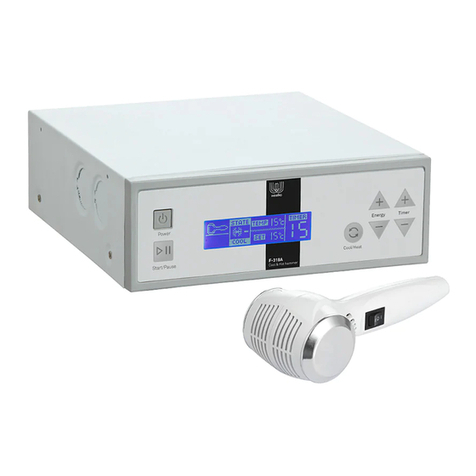
Weelko
Weelko B-Equipment instruction manual

Ofa Bamberg
Ofa Bamberg dynamics Knee Orthosis Classic Instructions for use
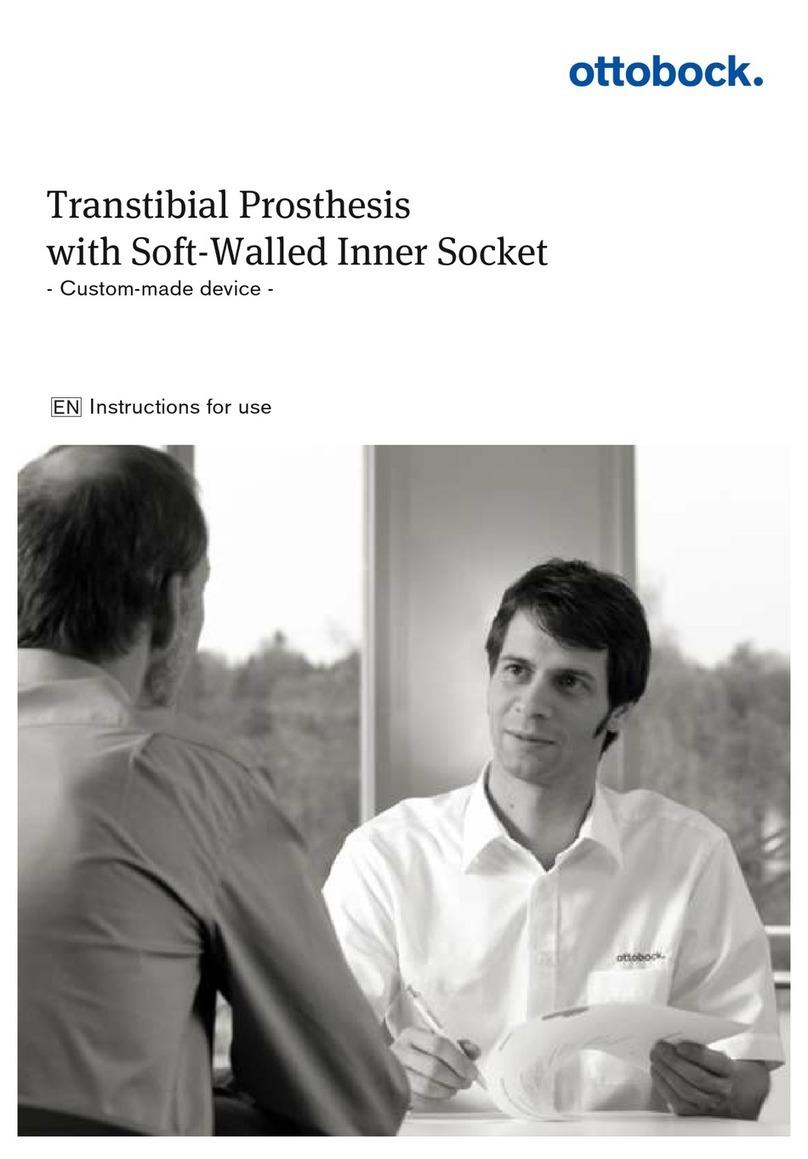
Otto Bock
Otto Bock Transtibial Prosthesis with Soft-Walled Inner... Instructions for use
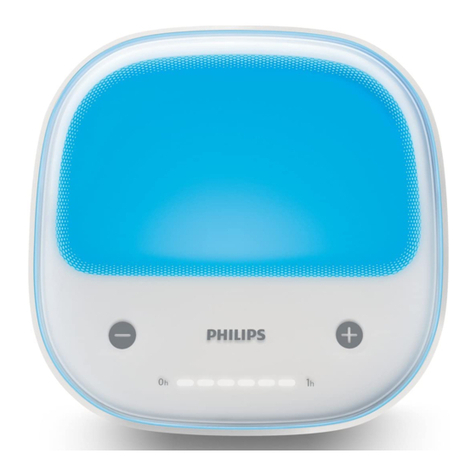
Philips
Philips HF3429 manual
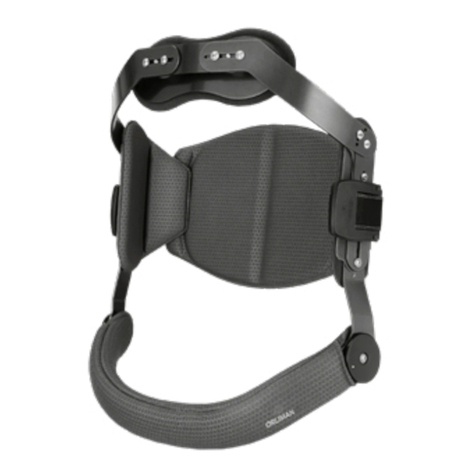
Orliman
Orliman Jewett STERNOTECH Use and maintenance instructions
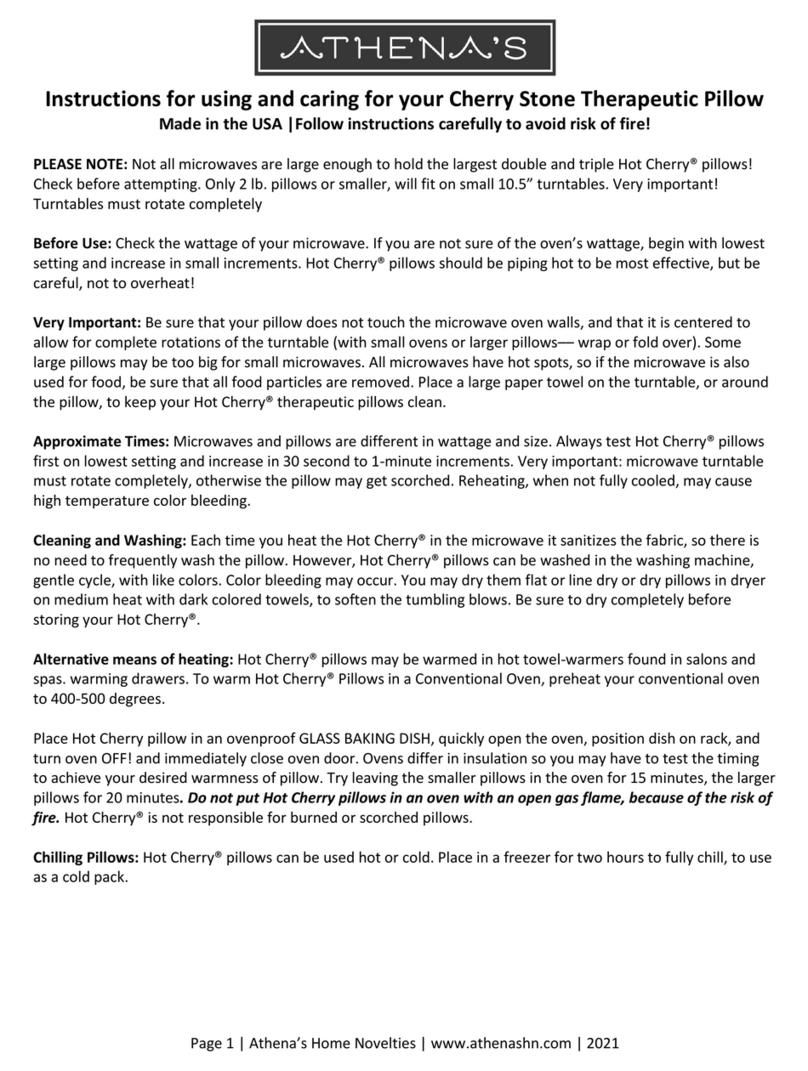
Athena's
Athena's Cherry Stone Instructions for using
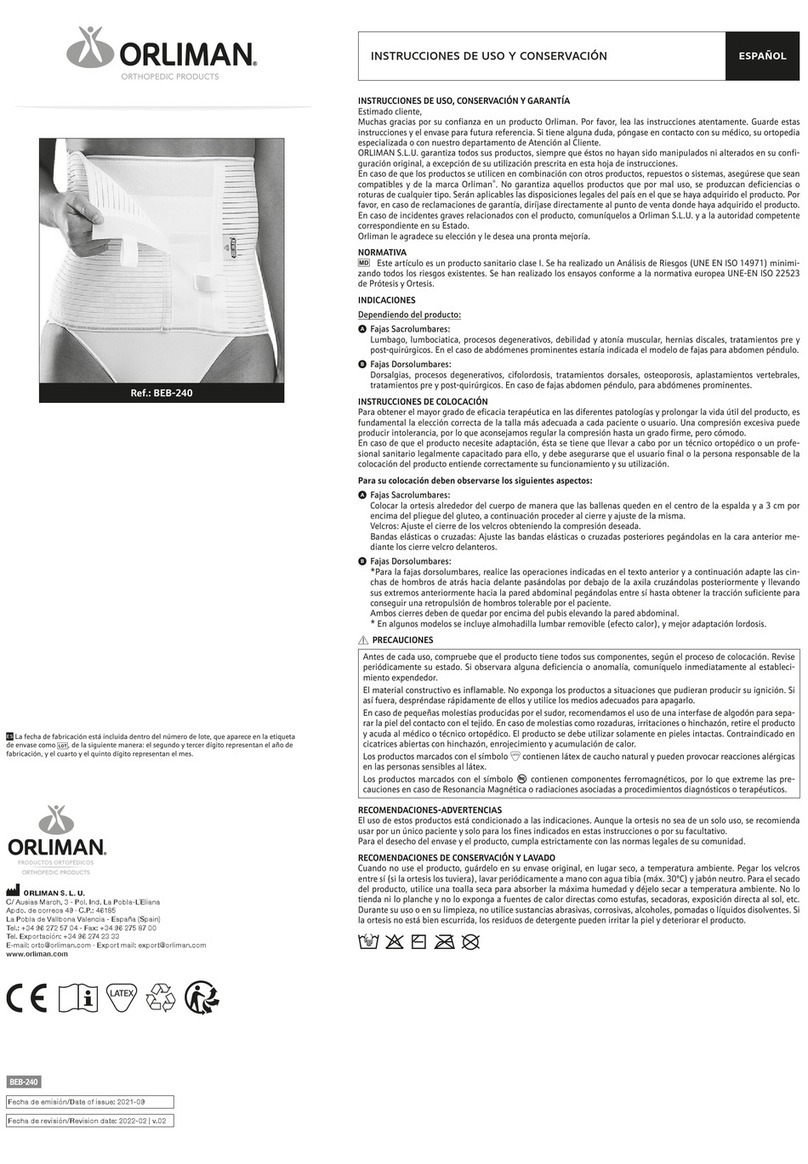
Orliman
Orliman BEB-240 Use and maintenance instructions
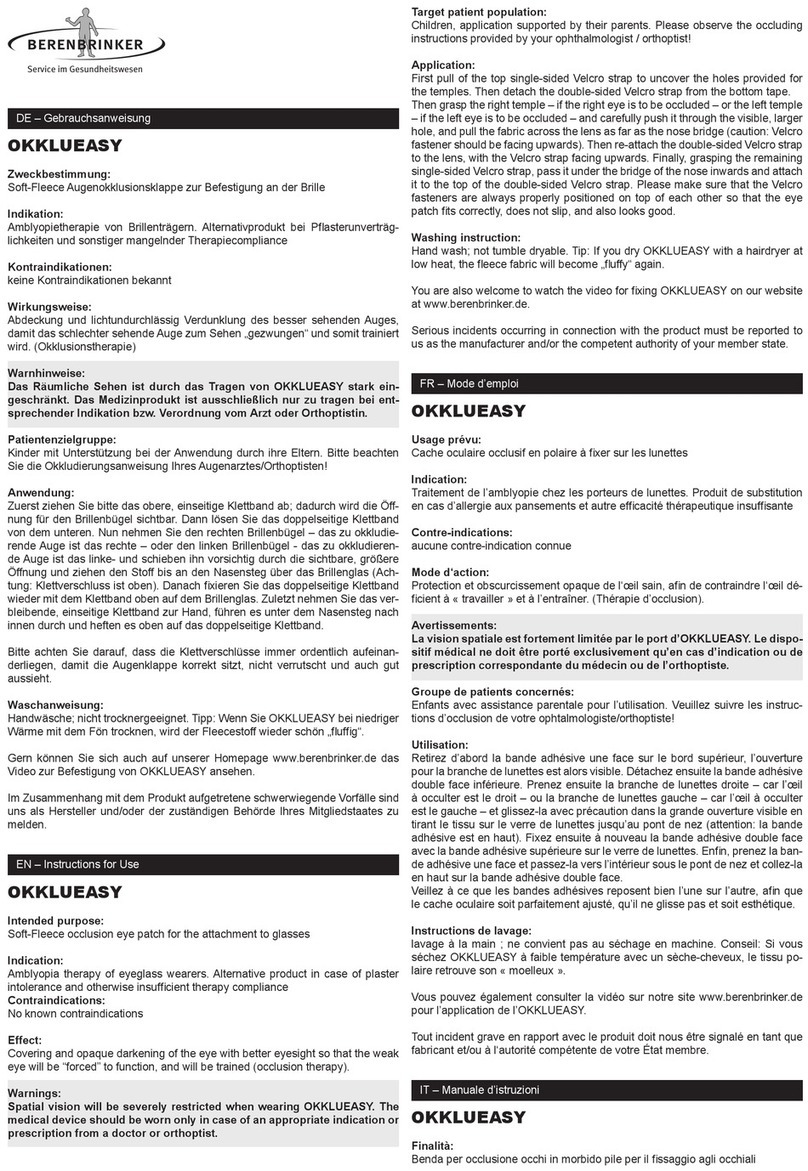
Berenbrinker
Berenbrinker OKKLUEASY Instructions for use

SelfCareOne
SelfCareOne SelfCare1 manual
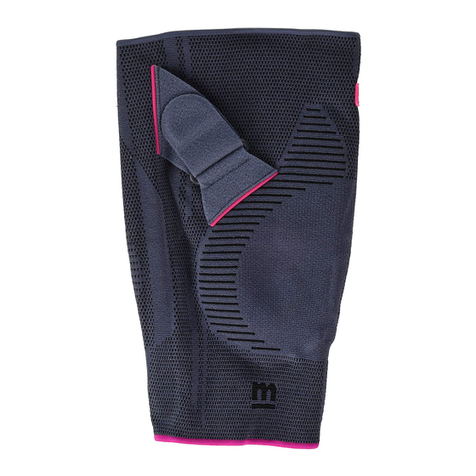
medi
medi Genumedi Instructions for use
